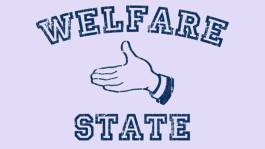 If I had a bitcoin for every time I’ve heard someone say that the US should be more like Europe…
If I had a bitcoin for every time I’ve heard someone say that the US should be more like Europe…
What they mean is that the US follows a harsh model of laissez faire capitalism, while Europe follows a kinder, gentler model of ‘democratic socialism.’ They would like the US to adopt a larger welfare state like Europe.
Here are some valid arguments against this.
Europe’s worse economic resultsThe first point to make is that Western Europe has produced worse economic results.
Growth: Over the past thirty years, European economic growth averaged 2.2% versus 2.6% in the US.
That 0.4% difference in growth rates may not seem like much, but in the long run will lead to dramatically different living standards. Today, the US is the most prosperous region in the world and Africa the least prosperous as a result of the US growing just 0.9% faster per year.
Strong economic growth is incredibly important for improving long-term prosperity (please read this post). It’s why capitalism will beat the welfare state in the long run.
Unemployment: Over the past thirty years, European unemployment averaged 9.7% versus 6.1% in the US.
Wages: The average wage in Europe is only three fourths of the US level.
Other than a blind obsession for expanding government, why would Americans wish to emulate Europe’s record of slower growth, higher unemployment, and lower incomes?
Europe has changedBesides, in recent decades many European countries have discovered that their welfare states are unaffordable or uncompetitive and have trimmed them back.
According to Ryan Streeter at AEI, the Scandinavian welfare systems are now actually more pro-work than in the US. Denmark eliminated disability benefits for people under 40. Sweden reduced unemployment benefits and emphasized a rapid transition from unemployment to work (as opposed to simply paying people to not work).
England streamlined and combined six welfare programs into one, and structured the new program to encourage greater work. Streeter reports that 86% of claimants under the new system try to increase their work hours, compared to only 38% under the previous system.
Germany has also taken significant steps. In the early 2000s, they combined and reduced welfare and unemployment benefits. They also made it easier to fire employees. (If that sounds harsh, understand that restrictions on firing understandably make businesses reluctant to hire more employees. Therefore, removing those restrictions allows job-creation to rise to its natural level.)
In France, the election of Macron suggests that reforms may be coming. Among other things, Macron wants to loosen highly restrictive labor laws to make it easier for businesses to fire workers.
I could list many more examples, but you get the idea.
The Fraser Institute’s ratings of overall economic freedom also indicate that Europe has loosened the grip of government. From 1975 to 2015, the average Western European country increased its economic freedom score by almost one third. Said differently, Western European economic freedom improved from 75% of the US level in 1975 to 97% of the US level in 2015.
Europe has changed. They discovered that a large and rigid welfare state makes economies uncompetitive and governments unaffordable. They swerved away from the cliff. Why would Americans want to rush toward that cliff?
Economic securityOne reason people desire a European-style welfare state is that it appears to promise more safety and security compared to the risk associated with free-market capitalism. In the long run, not likely.
A limited government safety net is reasonable and humane. However, the larger it becomes, the less sustainable it becomes.
Why? Because government punishes some people for working (taxpayers) while simultaneously rewarding other people for not working (recipients). At some point, the welfare state becomes unaffordable or uncompetitive.
The key point to understand is that long-term economic security depends on our ability to create economic value. Individuals can achieve security only if the value of their work output exceeds the cost of their pay. Companies can offer secure employment only if they are profitable.
The welfare state cannot deliver long-term economic security. Why not? Because government programs don’t create economic value, they redistribute it.
No matter how generous the welfare state, hardship will strike if the underlying economy fails to create sufficient economic value. That’s because the underlying economy funds the welfare state, and economic value that is not created cannot be redistributed. Greeks and Venezuelans can attest to these economic realities.
In the long run, a strong economy can deliver economic security even with a minimal safety net. However, a generous welfare state cannot deliver economic security unless it’s backed up by a strong economy. Although it may seem counter-intuitive, the growth of capitalism probably offers a better chance of long-term economic security than the welfare state.
Different culturesIn addition to any other issue, America has a different culture than Europe. Although many Americans are of European descent, US culture is different.
Europe eventually threw off the rule of monarchs, but America did so sooner and more emphatically. Therefore, US culture tends to value individual freedom and smaller government more than Europe.
In Europe, aristocratic lineage often defined one’s worth. Commercial success was often viewed as distasteful. In the US, people admired not aristocrats but people who invented things, people who went from rags to riches. Therefore, US culture tends to value commercial success and meritocracy more than Europe.
Americans tend to be more tolerant of risk and more open to innovation. Why? Perhaps because America is primarily populated by immigrants who left their home countries for a new start in a far-off land. Perhaps because early Americans essentially built a vibrant nation and economy out of relative wilderness.
Whatever the reasons, US culture differs from European culture. Therefore, we should think twice about grafting European-style government onto American culture.
US has a safety netFinally, some people claim that the US does not have much of an economic safety net. It may not be as much as they want, but it’s not nothing.
In 2016, the federal government spent $720 billion on means-tested programs. (Means-tested programs provide benefits only if the recipient’s income or assets are low enough. Medicaid, Earned Income Tax Credit, food stamps, etc.)
In that same year, 12.7% of the US population, or 40.6 million people, lived below the poverty line.
If we divide the $720 billion amongst all those people, that would equate to $17,700 of anti-poverty spending per person, or $53,000 for a 3-member household. This is not chump change.
Of course, households below the poverty line do not really see all $53,000. Some of this money goes to lower-income people above the poverty line. If we divide the $720 billion across the lowest one-third of income-earners, that equates to $20,500 per household.
Keep in mind that these figures do not include state and local government programs. Or private charity. Despite claims to the contrary, the US does provide a serious safety net.
ClosingLet’s recap why the US does not need to imitate the European welfare state:
- European economic results have been lackluster due in part to welfare statism.
- Europe itself has taken steps to reduce their welfare states.
- Long-term economic security and prosperity derive from a value-creating capitalist economy, not from the hollow assurances of a welfare state.
- A European-style welfare state is not fully compatible with US culture.
- The US already has a substantial safety net.
In my next two posts I will continue to explore this general topic of US versus Europe.
I encourage you to enter comments or questions below. Two rules: 1) be reasonably polite, 2) address the issue and avoid personal attacks.
Advertisements Share this:




